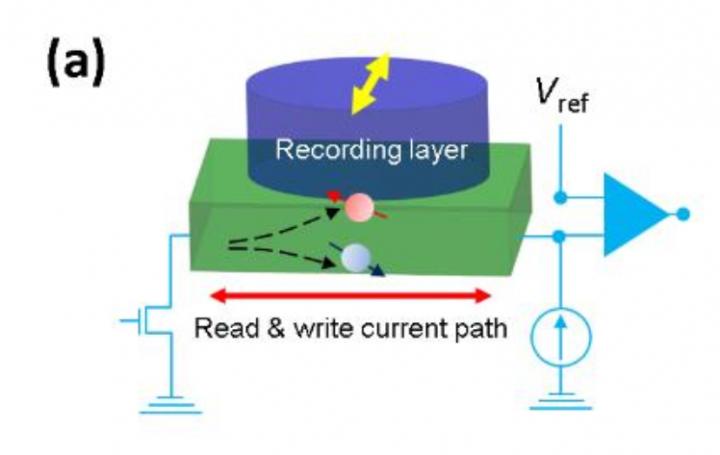Paving the way for spintronic RAMs: A deeper look into a powerful spin phenomenon

The proposed combination of materials serves as a memory unit by supporting read and write operations. The spin injection by the topological insulator (TI) material reverses the magnetization of the ferromagnetic (FM) material, representing the 'write' operation. Furthermore, the spin injection can also change the overall resistance of the materials, which can be sensed through an external circuit, representing the 'read' operation. Credit: Journal of Applied Physics
Spintronics is a modern technological field where the “spin” or the angular momentum of electrons takes a primary role in the functioning of electronic devices. In fact, collective spin arrangements are the reason for the curious properties of magnetic materials, which are popularly used in modern electronics.
Researchers globally have been trying to manipulate spin-related properties in certain materials, owing to a myriad of applications in devices that work on this phenomenon, especially in non-volatile memories. These magnetic non-volatile memories, called MRAM, have the potential to outperform current semiconductor memories in terms of power consumption and speed.
A team of researchers from Tokyo Tech, led by Assoc. Prof. Pham Nam Hai, recently published a study in Journal of Applied Physics on unidirectional spin Hall magnetoresistance (USMR), a spin-related phenomenon that could be used to develop MRAM cells with an extremely simple structure.
The spin Hall effect leads to the accumulation of electrons with a certain spin on the lateral sides of a material. The motivation behind this study was that the spin Hall effect, which is particularly strong in materials known as “topological insulators”, can results in a giant USMR by combining a topological insulator with a ferromagnetic semiconductor.
Basically, when electrons with the same spin accumulate on the interface between the two materials, (Fig. 1) due to the spin Hall effect, the spins can be injected to the ferromagnetic layer and flip its magnetization, allowing for “memory write operations”, which means the data in storage devices can be “re-written”.
At the same time, the resistance of the composite structure changes with the direction of the magnetization owing to the USMR effect. Because resistance can be measured using an external circuit, this allows for “memory read operations”, in which data can be read using the same current path with the write operation.
In existing material combination using conventional heavy metals for the spin Hall effect, however, the changes in resistance caused by the USMR effect are extremely low–well below 1%–which hinders the development of MRAMs utilizing this effect. In addition, the mechanism of the USMR effect seems to vary according to the combination of material used, and it is not clear which mechanism can be exploited for enhancing the USMR to over 1%.
To understand how material combinations can influence the USMR effect, the researchers designed a composite structure comprising a layer of gallium manganese arsenide (GaMnAs, a ferromagnetic semiconductor) and bismuth antimonide (BiSb, a topological insulator). Interestingly, with this combination, they were successful in obtaining a giant USMR ratio of 1.1%.
In particular, the results showed that utilizing phenomena called “magnon scattering” and “spin-disorder scattering” in ferromagnetic semiconductors can lead to a giant USMR ratio, making it possible to use this phenomenon in real-world applications.
Dr. Hai elaborates, “Our study is the first to demonstrate that it is possible to obtain an USMR ratio larger than 1%. This is several orders of magnitude higher than those using heavy metals for USMR. In addition, our results provide a new strategy to maximize the USMR ratio for practical device applications”.
This study could play a key role in the development of spintronics. Conventional MRAM structure requires about 30 ultrathin layers, which is very challenging to make. By utilizing USMR for read-out operation, only two layers are needed for the memory cells. “Further material engineering may further improve the USMR ratio, which is essential for USMR-based MRAMs with an extremely simple structure and fast reading. Our demonstration of an USMR ratio over 1% is an important step toward this goal,” concludes Dr. Hai.
Media Contact
All latest news from the category: Physics and Astronomy
This area deals with the fundamental laws and building blocks of nature and how they interact, the properties and the behavior of matter, and research into space and time and their structures.
innovations-report provides in-depth reports and articles on subjects such as astrophysics, laser technologies, nuclear, quantum, particle and solid-state physics, nanotechnologies, planetary research and findings (Mars, Venus) and developments related to the Hubble Telescope.
Newest articles

High-energy-density aqueous battery based on halogen multi-electron transfer
Traditional non-aqueous lithium-ion batteries have a high energy density, but their safety is compromised due to the flammable organic electrolytes they utilize. Aqueous batteries use water as the solvent for…

First-ever combined heart pump and pig kidney transplant
…gives new hope to patient with terminal illness. Surgeons at NYU Langone Health performed the first-ever combined mechanical heart pump and gene-edited pig kidney transplant surgery in a 54-year-old woman…

Biophysics: Testing how well biomarkers work
LMU researchers have developed a method to determine how reliably target proteins can be labeled using super-resolution fluorescence microscopy. Modern microscopy techniques make it possible to examine the inner workings…





















